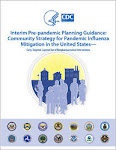# 3159
I understand that now that the A/H1N1 virus appears to be less severe than first feared, that there is a desire to ratchet down some of the public concern over the Swine Flu threat.
There is a danger that the pendulum will swing too far, however, and we end up with complacency again.
Public Health officials do want people to remain mindful of the importance of`flu etiquette’' this summer; washing hands, using alcohol hand sanitizer, covering coughs, staying home if ill . . . but they don’t want them to go around afraid.
And that makes sense.
And they also want people to be thinking about how they will handle things in the fall if this virus should return, perhaps with more virulence.
The Acting Director of the CDC, Dr. Richard Besser, made it a point in his Thursday and Friday remarks to recommend that people visit pandemicflu.gov and take the preparedness advice there seriously.
And that is excellent advice, as well.
These are common sense things that everyone can (and should) be doing right now.
But now I worry that I’m seeing reassuring statements in the press that intimate that the American people will have a vaccine come this fall.
I saw one this afternoon, in USA Today, that warned the H1N1 virus could return this fall, but assured that “a vaccine will likely be ready by the time a second wave hits.”
This is a comforting thought, I suppose.
But for most Americans, probably not true.
Despite having the question asked at almost every press briefing given by the CDC for the past two weeks, and getting the same honest response each time – `that they can’t say when a vaccine will be available, or how much will be available’ – reporters seem intent on finding other sources to quote.
There’s a reason why the CDC is being noncommittal about the availability of a vaccine.
They understand that rolling out a special swine flu vaccine program is a huge undertaking . . . with numerous opportunities for things to go wrong.
Yes, the CDC, the WHO, and vaccine manufacturers all over the world are in consultation over whether they will create a swine flu vaccine. And a decision on whether to produce a series of `pilot lots’ of vaccine, for animal and human testing later this summer, should be made in the next couple of weeks.
But even if that process, and the subsequent testing and full production run go well, the amount of vaccine that will be produced, and exactly who will receive it first are unanswered questions.
The CDC has already spoken of prioritization, a fancy word for deciding who goes to the front of the line for a vaccine.
They know that even if a vaccine is produced (and that decision hasn’t been made yet!), there won’t be enough – at first – for everyone.
Last year the HHS released a vaccine priority system (which could change) based on the assumption that there won’t be enough vaccine immediately available for everyone in the beginning of a pandemic.
(click to enlarge)
Just off the top of my head, here are just a few `challenges’ that could affect any pandemic vaccine program.
- The virus could mutate over the summer or fall, possibly rendering any vaccine being manufactured now less protective (or even useless).
- The virus may not grow well in eggs (that happens sometimes), reducing the amount of antigen that can be produced.
- They could discover problems during the animal and human testing phase, which can’t even begin until late July.
- The much vaunted global manufacturing capacity may not be as high as some have projected.
- People may need more than the standard 15 mcg flu shot to provoke an immune response, or need two shots, which would cut down on the number of doses that could be produced.
- The logistics of delivering a (prioritized) vaccine to hundreds of millions of people (possibly in two shots a month apart) over a short period of time are tremendous.
- And of course, there could be diplomatic wrangling over the sharing of vaccines with developing countries, or over the export of vaccine from the manufacturer’s country until their needs have been met.
If we see a return of the A/H1N1 virus (or any other pandemic strain) in the fall, most Americans will likely be more dependent upon the system of NPI’s (Non Pharmaceutical Interventions) described in the HHS’s Community Pandemic Mitigation Plan than they will any miracle vaccine.
If we are very lucky, we may see some vaccine available by fall for those working on the front lines; doctors, nurses, first responders and perhaps for those most at risk (pregnant women, toddlers, etc.).
If all goes well, over the winter months, additional groups (tiers) may receive a vaccine as more becomes available.
But the entire nation? This fall?
I wouldn’t put any money on it.
I know people want to be reassured.
But a mounting a pandemic vaccine program is a tremendous undertaking that is fraught with unimagined difficulties and whose outcome is not assured.
Blithely suggesting that we needn’t worry because, “a vaccine will likely be ready by the time a second wave hits”, sends the wrong message to the public.
That there is a pill or a shot that absolves them of any personal responsibility to prepare.
People need to be doing exactly what Dr. Richard Besser of the CDC has suggested.
They need to stay informed, practice good flu hygiene (now and forever), and they should be visiting pandemicflu.gov to learn how to prepare their families, their communities, and their businesses for what might be a pandemic flu season next fall.
If we don’t see a bad flu season this Fall, we as a nation will emerge from this summer of preparation with healthier respiratory habits, and will be better equipped to deal with any emergency that does come along.
Which, as outcomes go, isn’t half bad.

